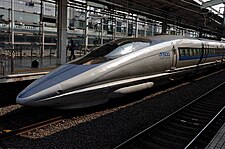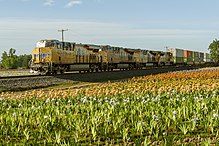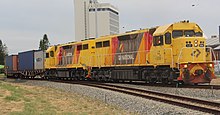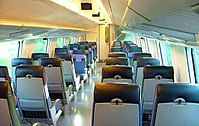Train
A train is a vehicle made up of a series of wagons or cars coupled together and towed by a locomotive, or by self-propelled cars that generally run on permanent rails. Trains are used to transport goods, animals or people from one place to another.
Trains have their origins in wagons that were propelled by horses or pulled by cables. Following the invention of the steam locomotive in the UK, trains expanded rapidly, allowing goods and passengers to move faster and cheaper, aiding industrialization and interconnection. As a result of the expansion of trains, projects such as the First Transcontinental Railroad in the United States, the Trans-Siberian Railroad, the Orient Express or the Panama Railroad arose between the middle of the century XIX and early XX century. However, starting in the 1920s, as a result of the invention of the automobile, the use of trains declined, a decline that accelerated after World War II. Currently, the use of trains is contemplated due to its greater fuel efficiency and lower greenhouse gas emissions compared to other modes of land transport, in addition, experimental trains such as magnetic levitation trains have been developed.
Etymology
This word or its equivalent is almost the same in English, French, Dutch, Spanish, Portuguese or Italian, it comes from English train and this one from Old French train, action of dragging (etymologically related to swallowing). The German and Scandinavian languages gave zug, tåg and tog, related to the English verb to tug, which has also the sense of dragging. Today we would define the train as a multiple vehicle, moved by mechanical means that circulates on a railway specially made for it.
Technological development of the train through history
It was about that vehicle that had its path marked by the ruts on which it circulated. The chariots were digging parallel grooves in the streets of Ur. The inhabitants soon realized that these ruts, when they were deep, kept the vehicles guided and did not damage, when driving, the houses next to which they passed, in the streets. narrow streets of the cities that watered the Tigris and the Euphrates. Later on, the dusty or muddy streets were covered with flagstones, deliberately leaving the necessary ruts for the carts to follow a fixed path. It must not be forgotten that the four-wheeled cart was then a recent invention, and that its rear axle was not steerable.
The railway was a product of the Industrial Revolution that emerged in England during the 18th and XIX.
A locomotive, to which wagons were added for human and cargo transport, are basically the parts that constitute a train to date.
Motorcycles or trains have been subject to technological advances and an example of this is the bullet train in Japan.
The builder of the first locomotive (July 25, 1804), which would later become a railway, was Richard Trevithick.
The initial destination of the locomotive was its use in coal mines, in whose first demonstration it was possible to drag a load of forty tons, at a speed of 6 km/h.
In 1823, the English Parliament approved the act that assured George Stephenson the ownership of a project, whose purpose was to unite the towns of Stockton and Darlington by means of a railway line.
Railroad rediscovery
In the 19th century, vestiges of the Roman Empire began to be discovered in many European countries, with the discovery of cities perfectly laid out with their fortifications, splendid country houses with a kind of central heating and running water, well-paved roads and also stone paths enabled for the circulation of carts with heavy loads. One of these roads was found in the British Isles, precisely where the Abbeydore railway station would later rise, on the border of England with Wales.
Those were the days of the guided vehicle, but not the railed road. The idea for this must have arisen when on the deeply rutted tracks, tree trunks split in half were placed, all along, to prevent the wheels of the wagons from sinking into the mud. These were the first lanes. Undoubtedly, such a system spread through the regions where it rained a lot and stone was scarce. The very essence of the rail road is the existence of ridges on the road or on the wheels. The stone paths had the edge of the rut.
In its primitive form, this wheel looked like a reel and the squared tree trunks (fir or larch) nailed to other shorter trunks forming right angles formed the track: rails mounted on sleepers. There were even rudimentary needles. It is not known who laid the first track, but in the 16th century they were already used in the gold mines of Transylvania, and Some examples of those primitive roads and the vehicles that circulated on them have survived the passage of time.
Development evidence
In various treatises from the 16th century there are illustrations depicting "those railways" and wooden rails. The best known is perhaps De Re Metallica, by Georgius Agrícola (Georg Bauer), published in 1556. The drawing of one of these tracks, in a mine in Alsace, is also found in the Cosmographica Universalis (1550) by Sebastián Münster. It is likely that prior to these dates, such tracks were used in mines in Eastern Europe and Tyrol.
So, according to our present knowledge, it seems that the idea of making a special road for carriages came from a Mesopotamian, and that the use of the flange wheel on a rail is due to an unknown German. The wagons used in the mines are called in German hunde (dogs). In the 18th century there were two rival systems: the flange wheel on ordinary rail (the current form) and the ordinary wheels on a rail with a flange or a groove. The latter, made up of L-shaped cast iron bars and supported on stones, provided a hard but useful track when the loads were not excessive. Throughout the century, numerous mine railways were built throughout Europe, particularly in Wales and in the north-west of England, where mining thrived. In Charles Edward Lee's book, The Evolution of Railways, which ends at the time when almost all works devoted to the subject begin, many details of that period are found.
During the 17th century, in Europe, especially in the North West of England, works were carried out to support the archaic mines. These were usually located under the hills and the wagon tracks descended to the nearest river or canal, where the boats collected the coal. To go up the hill, the horse(s) pulled the wagons and when going down the slopes under their own weight, the animals were in the tail vehicle. In County Durham, England, the world's first railway viaduct, the Causey Arch in Tanfield, built in 1727, remains.
Passenger trains
Short distance trains
They are those trains that only transport passengers within a certain territory or city.
Suburban and regional train
Metropolitan train
This is the name given to the underground or elevated "railway systems for mass passenger transport" and in some cases partially on the surface and by trench-type rail, which operate in large cities to unite various areas of their municipal area and their closest surroundings, with high capacity and frequency, and separated from other transportation systems with overpasses.
Long distance trains
High speed train
A notable and growing category of long-distance trains is high-speed rail (TAV), which typically runs at speeds in excess of 200–250 km/h and often operates on purpose-built tracks that are inspected and prepared to adapt to high speeds. The first successful example of a high-speed passenger rail system was Japan's Shinkansen, colloquially known as the 'bullet train', which began operation in October 1964 linking Tokyo and Osaka; his train reached a speed of 240 km/h.
In France, the TGV (Train à Grande Vitesse, literally "high-speed train") is one of the trains that in April 2009 achieved a world speed record: 574.8 km/h, twice the take-off speed of a Boeing 727 plane. However, the world record for trains is held by the Japanese Maglev, a magnetic levitation train, which in April 2015 achieved a maximum speed of 603 km/h. Another high-speed train in France is the much more modern AGV (Automotive High Speed). In Japan, in addition to the Maglev, there are the Shinkansen that reach speeds of more than 300 km/h.
The TGV operates at a maximum revenue speed of 300 to 320 km/h (190 to 200 mph), as does Germany's ICE (Inter-City Express) and Spain's AVE (Alta Velocidad Española). The highest speed currently achieved in scheduled revenue operation is 350 km/h (220 mph) on the high-speed Beijing-Tianjin and Wuhan-Guangzhou intercity rail systems in China.
In most cases, high-speed rail travel is time and cost competitive with air travel when distances do not exceed 500 to 600 km, as check-in and boarding procedures at the airport can add at least two hours to the total transit time. [9] In addition, rail operating costs over these distances may be less when the amount of jet fuel consumed by an aircraft during takeoff and climb is taken into account. Air travel becomes more cost competitive as travel distance increases because fuel accounts for less of the plane's overall operating cost.
In Germany the ICE (Inter City Express) was developed in 1985.
In Spain the AVE (Spanish High Speed) reaches speeds of over 300 km/h. Its first service was between Madrid and Seville in 1992.
In Italy the ETR or Pendolinos are trains capable of tilting or "pendular" at high speeds in tight curves of traditional tracks. A precedent for pendolinoss can be found in the Spanish Talgo.
Other train systems
Light Rail
The light rail is a train of the tram family, in certain cases high-floor with stations with platforms, which circulates in segments partially or totally segregated from vehicular traffic, with reserved lanes, secluded tracks and in some cases by tunnels or on the surface of the city center.
Magnetic levitation train
The magnetic levitation train is a train suspended in the air above a track by magnetic levitation.
Monorail
The monorail or monorail was developed to satisfy the demand of medium traffic in public transport in urban areas.
Freight train
A freight train (or "freight train") uses freight cars (also known as "trucks" or "freight cars") to transport goods or materials (freight), basically any train that is not used to carry passengers. Much of the world's cargo is transported by rail.
Under the right circumstances, freight transport by rail is extremely economical and also more energy efficient than freight transport by road. Rail freight transport is most economical when goods are transported in bulk and over long distances, but is less suitable for short distances and small loads. Bulk aggregate movements of as little as 30 km can be profitable, even taking into account the transshipment costs that dominate in many cases; Modern practices, such as intermodal container shipping, aim to minimize these costs.
The main disadvantage of rail freight is its lack of flexibility and for this reason rail has lost much of the freight business to road competition. Many governments are trying to encourage more freight back onto trains because of the benefits it would bring.
There are many different types of freight trains, used to transport a wide variety of different types of cargo, with various types of wagons. One of the most common types on modern railways are intermodal (container) trains, where containers can be hoisted on and off the train by cranes and loaded onto trucks or ships. In the US, this type of freight train has largely replaced the traditional boxcar (freight car) type of freight train, which requires freight to be manually loaded or unloaded. In Europe, the sliding wall wagon has replaced the ordinary covered goods wagon.
Propulsion
Early trains were rope-pulled, gravity-powered, or horse-drawn, but since the early 19th century almost all trains were powered by steam locomotives. Starting in the 1910s, steam locomotives began to be replaced by diesel and electric locomotives; although these new forms of propulsion were far more complex and expensive than steam power, they required less labor and were cleaner. At around the same time, self-propelled multiple unit vehicles (both diesel and electric) became much more widely used in passenger service. Dieselisation of locomotives in everyday use was completed in most countries by the 1970s. Steam locomotives are still in use on heritage railways operated in many countries for the leisure and enthusiast market.
Electric traction offers a lower cost per kilometer of train operation, but at a higher initial cost, which can only be justified on high-traffic lines. Although the cost per kilometer of construction is much higher, electric traction is more viable during operation because diesel import costs are substantially higher. Electric trains receive their current through overhead lines or through a third rail electrical system.
A technology under development is fuel cells, which combine the advantage of not requiring an installed electrical system with the advantage of emission-free operation. However, one impediment is the substantial initial cost associated with fuel cell vehicles.
Today's trains are usually powered by electric motors, by diesel-electric or hydraulic systems, or by direct diesel engine. Some hybrid trains incorporate both electric and diesel-electric motorization.
Proposals for the near future
In the middle of the [[XX]] century, the erroneous idea spread according to which trains (and with them the railroad) were an "obsolete" soon to be replaced by the automobile and the airplane. The refutation of such ideas was revealed in the first energy crisis of the 1970s: a traditional train can transport more people faster and safer, as well as with less energy expenditure, than several cars or several buses (the least cost energy is easily explained: a train with only one motor traction system can transport the load of several trucks or buses that each use separate tractions). Regarding competition with air traffic, it almost does not exist if short and medium distances (up to approximately 1,000 km) are involved, as train speeds have increased and airspace has become dangerously congested (mainly in Europe). Occidental, United States, Japan and its adjacencies).
In Switzerland, a system called Swissmetro has been proposed, a kind of "remote commuter trains". These would be High Speed trains that would circulate through two parallel tunnels (round trip) with the particularity that the air inside them would circulate at a speed similar to that of trains (also with round trip), which would eliminate the friction, with great energy savings. At first it was thought of putting magnetic levitation trains, but then it was changed to normal high-speed trains so that international trains could run on the same tracks.
Trains generate50 times less CO2 than planes and
40 times less than cars.
The "futurist" (which is possible in the near future) include trains whose locomotives are powered by powerful hydrogen cell engines instead of the familiar diesel engines. Sheldon Weinbaum and Bruce Logan are some of the main researchers and designers of large engines that would use hydrogen as fuel for the engines of the new locomotives; Logan takes the ecological proposal to obtain hydrogen from electrolysis induced by bacteria in biodegradable waste.
Frank Randak, observing the large traffic congestion that occurs on the roads (mainly on the highways), proposes a system called AVT (Advanced Vehicle Transport / Transporte Vehicular Avanzado) that would consist of in large and fast trains that would carry a large number of cars with their passengers (in a similar way to the system already tested with effective results in the tunnel under the English Channel). This AVT system would largely replace highways, especially in interurban sections in which there are large traffic jams or high risk of traffic accidents.
Robert Pullam proposes an ultra-modern and ingenious system which he calls Tubular Rail or TRI. This would dispense with rail systems, which are onerous to build and maintain; instead the rails would be supplanted by spaced, elevated structures through which trains would rush. Such trains would be part of their route practically "flying" a few tens of meters. The Tubular Rail or "riel" The tubular could have several levels, so that several fast trains could circulate at the same time, although in parallel.
The ITC is another elevated train proposal. Its main characteristics are the use of MAGLEV technology and, especially, the existence of photovoltaic panels along the entire stretch of its route. Large expanses of photovoltaic panels would make it possible to produce additional electrical energy instead of just consuming it.
Aerotrain projects that seemed to be shelved in the 1980s have been reactivated particularly with the proposals of Yasuaki Kohama.
Much more unlikely and totally impossible with current technology is any gravitational train project (Gravity train not to be confused with the Gravity railroad), a system that is It is based on the hypothetical construction of very long underground tunnels with sections at great depth. Such hypothetical tunnels would be "in vacuum" to avoid the friction that would slow down the initial acceleration caused by using the natural force of gravity of the planet.
Acceptances
- Ascendant: it is called an ascending train to which the trajectory of its movement goes in the sense of the increase of the kilometer marks of the railway.
- Botijo: the one in Spain, during the summer, moved, without many comforts, to places of vacation.
- Carreta: in Argentina it was called the slow trains for the regional service.
- Lane: the one for the transport of lanes.
- Collector (unusedly): the goods that he was leaving or collecting carriages through the stations of his journey.
- Conventional: train formed by one or more locomotives and towed vehicles of any kind.
- Mail: the one normally intended to transport public correspondence.
- Nearby: the one that connects a populous city with neighboring towns.
- Scale (unused): the one that stops at all stations to take and leave travelers, orders, etc.
- High speed: the one that must circulate at a very high minimum speed by specially designed pathways.
- Of goods: the one carrying loads and not passengers.
- Descending: the one that his trajectory goes in the sense of the decrease of the kilometric marks of the railway.
- Direct: the one that circulates without stopping at the intermediate stations.
- Express: that of travelers who circulate at night and stops only at the main stations of the route.
- Special: the one that your circulation schedule has not been published in the book itinerary or analog document.
- Lechero: in Paraguay and Argentina it was so called the slow trains for the metropolitan and regional service.
- Board: the one that drives passengers and goods.
- Bus: the one carrying cars of all kinds and for all stations.
- Hurry: the one that circulates in the day and stops only in the main stations of the route.
- Regular: the one that your schedule has been published in the book itinerary or analog document.
- Reversible or push-pull: train with the locomotive in line governed from the cabin car cabin in the first place. When the brake is governed from this cabin, but not the traction, it is called a pushed train.
- Tram: that of travelers who make a short journey and for all stops.
Gallery
- Train
Contenido relacionado
1927
Eleventh century
1st century BC c.
















